Structure, Diversity, and Carbon Stocks of the Tree Community of Kumasi, Ghana
Abstract
:1. Introduction
2. Materials and Methods
2.1. Study Area
2.2. Vegetation Sampling
2.3. Data Analysis
3. Results
3.1. Species Diversity and Composition
3.2. Urban Forest Structure and Diversity
3.3. The Structure and Composition of the Urban Zones
3.4. Carbon Storage among Diameter Classes
4. Discussion
4.1. Species Diversity and Composition among Green Space Types
4.2. The Forest Structure and Carbon Storage in Green Spaces of Kumasi
4.3. Implications for Conservation
- Deliberate efforts to expand the urban forest in Kumasi and indeed across Ghana and Africa ought to be pushed forward. This requires planting and conserving a wide variety of native species as well as well-adapted economically-beneficial exotic species, especially in the HDUZ (core) areas of the city.
- Although invasive species are currently not studied within Kumasi, it is worth noting that some exotic species could potentially be invasive. Therefore, practitioners should judiciously select species when implementing urban afforestation programs.
- Grasslands and farmlands which are commonly found along wetlands in Kumasi could be planted with trees of assorted species mixes and excluded or protected from build-up development. In this regard, a form of urban agroforestry could be practiced, while at the same time helping urbanites adhere to the 100 m no development zones near water bodies in urban areas in Ghana.
- Biodiversity in public parks and wetlands within Kumasi could be further guided and protected by formidable policies. This will perhaps require bye-laws enacted by the metropolitan authorities in conjunction with the communities.
- Considering that home gardens support a high wealth of diversity and are at risk of being cleared for further housing development as and when the economic situation of the land owner permits, it is suggested that clear policy directions be enacted, demanding every parcel of land designated for housing to maintain a certain minimum amount of green cover and tree cover.
- Both in situ and ex situ conservation measures ought to be adopted to conserve indigenous species in these landscapes, especially rare species and/or shade-tolerant species.
- Stakeholders in urban forest (ry) need to explore better ways of making urban biodiversity profitable in order to generate income and enhance environmental sustainability. Examples are adhering to best management practices within no-development zones along waterbodies and using these riverine corridors for tourism to generate income.
5. Conclusions
Author Contributions
Funding
Acknowledgments
Conflicts of Interest
References
- Ghana Statistical Service. 2010 Population and Housing Census Final Results Ghana Statistical Service; Ghana Statistical Service: Accra, Ghana, 2012. [Google Scholar]
- United Nations. World Urbanization Prospects; United Nations: New York, NY, USA, 2014. [Google Scholar]
- Nero, B.F. Urban green space dynamics and socio-environmental inequity: Multi-resolution and spatiotemporal data analysis of Kumasi, Ghana. Int. J. Remote Sens. 2017, 38, 6993–7020. [Google Scholar] [CrossRef]
- Nero, B.F. Urban Green Spaces Enhance Carbon Sequestration and Conserve Biodiversity in Cities of the Global South: Case of Kumasi Ghana; University of Bonn: Bonn, Germany, 2017. [Google Scholar]
- Konijnendijk, C.C.; Ricard, R.M.; Kenney, A.; Randrup, T.B. Defining urban forestry—A comparative perspective of North America and Europe. Urban For. Urban Green. 2006, 4, 93–103. [Google Scholar] [CrossRef]
- Escobedo, F.; Seitz, J.A.; Zipperer, W. Gainesville’s Urban Forest Structure and Composition; University of Florida IFAS Extension: Gainesville, FL, USA, 2009; pp. 1–3. [Google Scholar]
- Fuwape, J.A.; Onyekwelu, J.C. Urban Forest Development in West Africa: Benefits and Challenges. J. Biodivers. Ecol. Sci. 2011, 1, 77–94. [Google Scholar]
- Sanders, R.A. Some determinants of urban forest structure. Urban Ecol. 1984, 8, 13–27. [Google Scholar] [CrossRef]
- Mcbride, J.R.; Jacobs, D.F. Urban forest structure: A key to urban forest planning. Calif. Agric. 1979, 33, 24. [Google Scholar]
- Sæbø, A.; Benedikz, T.; Randrup, T.B. Selection of trees for urban forestry in the Nordic countries. Urban For. Urban Green. 2003, 2, 101–114. [Google Scholar] [CrossRef]
- Buckelew Cumming, A.; Nowak, D.J.; Twardus, D.B.; Hoehn, R.E.; Mielke, M.; Rideout, R. The Urban Forest of Wisconsin 2002—Pilot Monitoring Project 2002; United States Forest Service: Washington, DC, USA, 2007. [Google Scholar]
- Escobedo, F.J.; Nowak, D.J.; Wagner, J.E.; Luz de la Maza, C.; Rodriguez, M. The socioeconomics and management of Santiago de Chile urban forest. Urban For. Urban Green. 2006, 4, 105–114. [Google Scholar] [CrossRef]
- Nowak, D.J.; Crane, D.E.; Stevens, J.C.; Hoehn, R.E.; Walton, J.T.; Bond, J. A Ground-Based Method of Assessing Urban Forest Structure and Ecosystem Services. Aboric. Urban. For. 2008, 34, 347–358. [Google Scholar]
- Nowak, D.J.; Crane, D.E. Carbon storage and sequestration by urban trees in the USA. Environ. Pollut. 2002, 116, 381–389. [Google Scholar] [CrossRef]
- Nielsen, A.B.; Östberg, J.; Delshammar, T. Review of urban tree inventory methods used to collect data at single-tree level. Arboric. Urban. For. 2014, 40, 96–111. [Google Scholar]
- Alonzo, M.; Mcfadden, J.P.; Nowak, D.J.; Roberts, D.A. Mapping urban forest structure and function using hyperspectral imagery and lidar data. Urban For. Urban Green. 2016, 17, 135–147. [Google Scholar] [CrossRef] [Green Version]
- Davies, Z.G.; Edmondson, J.L.; Heinemeyer, A.; Leake, J.R.; Gaston, K.J. Mapping an urban ecosystem service: Quantifying above-ground carbon storage at a city-wide scale. J. Appl. Ecol. 2011, 48, 1125–1134. [Google Scholar] [CrossRef]
- Kim, G. Assessing Urban Forest Structure, Ecosystem Services, and Economic Benefits on Vacant Land. Sustainability 2016, 8, 679. [Google Scholar] [CrossRef]
- Schreyer, J.; Tigges, J.; Lakes, T.; Churkina, G. Using airborne LiDAR and QuickBird data for modelling urban tree carbon storage and its distribution—A case study of Berlin. Remote Sens. 2014, 6, 10636–10655. [Google Scholar] [CrossRef]
- Food and Agriculture Organization of the United Nations (FAO). Urban and Peri-Urban Forestry in Africa: The Outlook for Woodfuel; FAO: Rome, Italy, 2012. [Google Scholar]
- Department for International Development (DFID). Forest Inventory Project, Ghana; DFID: London, UK, 2004. [Google Scholar]
- Treue, T. National Forest Inventory Continued (1989–1997). In Politics and Economics of Tropical High Forest Management; Kluwer Academic Publishers: South Holland, The Netherlands, 2001; pp. 37–38. [Google Scholar]
- Owusu, K. Changing Rainfall Climatology of West Africa: Implications for Rainfed Agriculture in Ghana and Water Sharing in the Volta Basin; University of Florida: Gainesville, FL, USA, 2009. [Google Scholar]
- Manu, A.; Twumasi, Y.A.; Coleman, T.L. Is It the Result of Global Warming or Urbanization? The Rise in Air Temperature in Two Cities in Ghana. In Proceedings of the 5th FIG Regional Conference, Accra, Ghana, 8–11 March 2006. [Google Scholar]
- Kumasi Metropolitan Assembly (KMA). The Composite Budget of the Kumasi Metropolitan Assembly (KMA) for the 2013 Fiscal Year; KMA: Kumasi, Ghana, 2013. [Google Scholar]
- Adarkwa, K.K. The role of Kumasi in national development—Kumasi as a central place. In Future of the Tree: Towards Growth and Development of Kumasi; Adarkwa, K.K., Ed.; University Printing Press: Kumasi, Ghana, 2011; pp. 14–34. [Google Scholar]
- Hawthorne, W.; Gyakari, N. Photoguide for the Forest Trees of Ghana; Trees Spotters’s Field Guide for Identifying the Largest Trees; Oxford Forestry Institute: Oxford, UK, 2006. [Google Scholar]
- Oteng-Amoako, A.A. 100 Tropical African Timber Trees from Ghana: Tree Description and Wood Identification with Notes on Distribution, Ecology, Silviculture, Ethnobotany, and Wood Uses; Forest Research Institute of Ghana: Kumasi, Ghana, 2002. [Google Scholar]
- Chave, J.; Réjou-Méchain, M.; Búrquez, A.; Chidumayo, E.; Colgan, M.S.; Delitti, W.B.C.; Duque, A.; Eid, T.; Fearnside, P.M.; Goodman, R.C.; et al. Improved allometric models to estimate the aboveground biomass of tropical trees. Glob. Chang. Biol. 2014, 20, 3177–3190. [Google Scholar] [CrossRef] [PubMed]
- Food and Agriculutre Organization of the United Nations (FAO). Estimating Biomass and Biomass Change of Tropical Forests; FAO: Rome, Italy, 1997. [Google Scholar]
- Orwa, S.; Mutua, A.; Kindt, R.; Jamnadass, R.H.; Simons, A. Agroforestree Database: A Tree Reference and Selection Guide, Version 4.0; World Agroforestry Center: Nairobi, Kenya, 2009. [Google Scholar]
- Martin, A.R.; Thomas, S.C. A reassessment of carbon content in tropical trees. PLoS ONE 2011, 6. [Google Scholar] [CrossRef] [PubMed]
- Chao, A.; Chazdon, R.L.; Colwell, R.K.; Shen, T.J. Abundance-based similarity indices and their estimation when there are unseen species in samples. Biometrics 2006, 62, 361–371. [Google Scholar] [CrossRef] [PubMed]
- Chao, A.; Chazdon, R.L.; Shen, T.J. A new statistical approach for assessing similarity of species composition with incidence and abundance data. Ecol. Lett. 2005, 8, 148–159. [Google Scholar] [CrossRef]
- Koleff, P.; Gaston, K.J.; Lennon, J.J. Measuring Beta Diversity for Presence-Absence Data. J. Anim. Ecol. 2003, 72, 367–382. [Google Scholar] [CrossRef]
- Konijnendijk, C.C.; Gauthier, M. Urban Forestry for Multifunctional Urban Land Use; RUAF Foundation: Leusden, The Netherlands, 2014. [Google Scholar]
- Pappoe, A.N.M.; Armah, F.A.; Quaye, E.C.; Kwakye, P.K.; Buxton, G.N.T. Composition and stand structure of a tropical moist semi-deciduous forest in Ghana. Plant Sci. 2010, 1, 95–106. [Google Scholar]
- Kankam, B.O.; Saj, L.; Sicotte, P. Short-term variation in forest dynamics: Increase in tree diversity in Boabeng-Fiama, monkey sanctuay, Ghana. Ghana J. For. 2013, 29, 19–33. [Google Scholar]
- Enninful, R. Assessment of Floral Compostion, Structure and Natural Regeneration of the Tano Offin Globally Significant Biodiversity Area; Kwame Nkrumah University of Science and Technology: Kumasi, Ghana, 2013. [Google Scholar]
- Anglaaere, L.C.N.; Cobbina, J.; Sinclair, F.L.; McDonald, M.A. The effect of land use systems on tree diversity: Farmer preference and species composition of cocoa-based agroecosystems in Ghana. Agrofor. Syst. 2011, 81, 249–265. [Google Scholar] [CrossRef]
- McKinney, M.L. Urbanization as a major cause of biotic homogenization. Biol. Conserv. 2006, 127, 247–260. [Google Scholar] [CrossRef]
- McKinney, M.L. Effect of urbanization on species richness: A review of plants and animals. Urban Ecosyst. 2008, 11, 161–176. [Google Scholar] [CrossRef]
- Agbelade, A.D.; Onyekwelu, J.C.; Oyun, M.B. Tree Species Richness, Diversity, and Vegetation Index for Federal Capital Territory, Abuja, Nigeria. Int. J. For. Res. 2017, 2017. [Google Scholar] [CrossRef]
- Raoufou, R.; Kouami, K.; Koffi, A. Woody plant species used in urban forestry in West Africa: Case study in Lomé, capital town of Togo. J. Hortic. For. 2011, 3, 21–31. [Google Scholar]
- Simmering, D.; Addai, S.; Geller, G.; Otte, A. A university campus in peri-urban Accra (Ghana) as a haven for dry-forest species. Flora Veg. Sudano-Sambesica 2013, 16, 10–21. [Google Scholar]
- Quagraine, V.K. Urban landscape depletion in the Kumasi Metropolis. In Future of the Tree: Towards Growth and Development of Kumasi; Adarkwa, K.K., Ed.; University Printing Press: Kumasi, Ghana, 2011; pp. 212–233. [Google Scholar]
- Asomani-Boateng, R. Urban Cultivation In Accra: An Examination of The Nature, Practices, Problems, Potentials And Urban Planning Implications. Habitat Int. 2002, 26, 591–607. [Google Scholar] [CrossRef]
- Hall, J.B.; Swaine, M.D. Classification and Ecology of Closed-Canopy. J. Ecol. 1976, 64, 913–951. [Google Scholar] [CrossRef]
- Fayolle, A.; Swaine, M.D.; Bastin, J.-F.; Bourland, N.; Comiskey, J.; Dauby, G.; Doucet, J.-L.; Gillet, J.-F.; Gourlet-Fleury, H.S.; Kirunda, O.J.B.; et al. Patterns of tree species composition across tropical African forests. J. Biogeogr. 2014, 41, 2320–2331. [Google Scholar] [CrossRef]
- Kacholi, D.S. Analysis of Structure and Diversity of the Kilengwe Forest in the Morogoro Region, Tanzania. Int. J. Biodivers. 2014, 2014. [Google Scholar] [CrossRef]
- Westphal, C.; Tremer, N.; Von Oheimb, G.; Hansen, J.; Von Gadow, K.; Ha, W. Is the reverse J-shaped diameter distribution universally applicable in European virgin beech forests? For. Ecol. Manag. 2006, 223, 75–83. [Google Scholar] [CrossRef]
- Armstrong, A.H.; Shugart, H.H.; Temilola, E. Characterization of community composition and forest structure in a Madagascar lowland rainforest. Trop. Conserv. Sci. 2011, 4, 428–444. [Google Scholar] [CrossRef]
- Chave, J.; Andalo, C.; Brown, S.; Cairns, M.; Chambers, J.Q.; Eamus, D.; Fölster, H.; Fromard, F.; Higuchi, N.; Kira, T.; et al. Tree allometry and improved estimation of carbon stocks and balance in tropical forests. Oecologia 2005, 145, 87–99. [Google Scholar] [CrossRef] [PubMed]
- Sullivan, M.J.P.; Talbot, J.; Lewis, S.L.; Phillips, O.L.; Qie, L.; Begne, S.K.; Chave, J.; Cuni-Sanchez, A.; Hubau, W.; Lopez, G.; et al. Diversity and carbon storage across the tropical forest biome. Sci. Rep. 2017, 7. [Google Scholar] [CrossRef] [PubMed]
- Rahman, M.A.; Moser, A.; Gold, A.; Rötzer, T.; Pauleit, S. Vertical air temperature gradients under the shade of two contrasting urban tree species during different types of summer days. Sci. Total Environ. 2018, 633, 100–111. [Google Scholar] [CrossRef] [PubMed]
- Rahman, M.A.; Armson, D.; Ennos, A.R. A comparison of the growth and cooling effectiveness of five commonly planted urban tree species. Urban Ecosyst. 2015, 18, 371–389. [Google Scholar] [CrossRef]
- Moser, A.; Rahman, M.A.; Pretzsch, H.; Pauleit, S.; Rötzer, T. Inter- and intraannual growth patterns of urban small-leaved lime (Tilia cordata mill.) at two public squares with contrasting microclimatic conditions. Int. J. Biometeorol. 2017, 61, 1095–1107. [Google Scholar] [CrossRef] [PubMed]
- International Union for Conservation of Nature (IUCN). IUCN Red Lists of Threatened Species; IUCN: Gland, Switzerland, 2013. [Google Scholar]
- Aronson, M.F.J.; La Sorte, F.A.; Nilon, C.H.; Katti, M.; Goddard, M.A.; Lepczyk, C.A.; Warren, P.S.N.; Williams, S.G.; Cilliers, S.; Clarkson, B.; et al. A global analysis of the impacts of urbanization on bird and plant diversity reveals key anthropogenic drivers. Proc. R. Soc. B Biol. Sci. 2014, 281. [Google Scholar] [CrossRef] [PubMed]
- Bulafu, C.; Baranga, D.; Mucunguzi, P.; Telford, R.J.; Vandvik, V. Massive structural and compositional changes over two decades in forest fragments near Kampala, Uganda. Ecol. Evol. 2013, 31, 3804–3823. [Google Scholar] [CrossRef] [PubMed]
- Deikumah, J.P.; Kudom, A.A. Biodiversity Status of Urban Remnant Forests in Cape Coast, Ghana. J. Sci. Technol. 2010, 30, 1–8. [Google Scholar] [CrossRef]
- Faeth, S.H.; Bang, C.; Saari, S. Urban biodiversity: Patterns and mechanisms. Ann. N. Y. Acad. Sci. 2011, 1223, 69–81. [Google Scholar] [CrossRef] [PubMed]
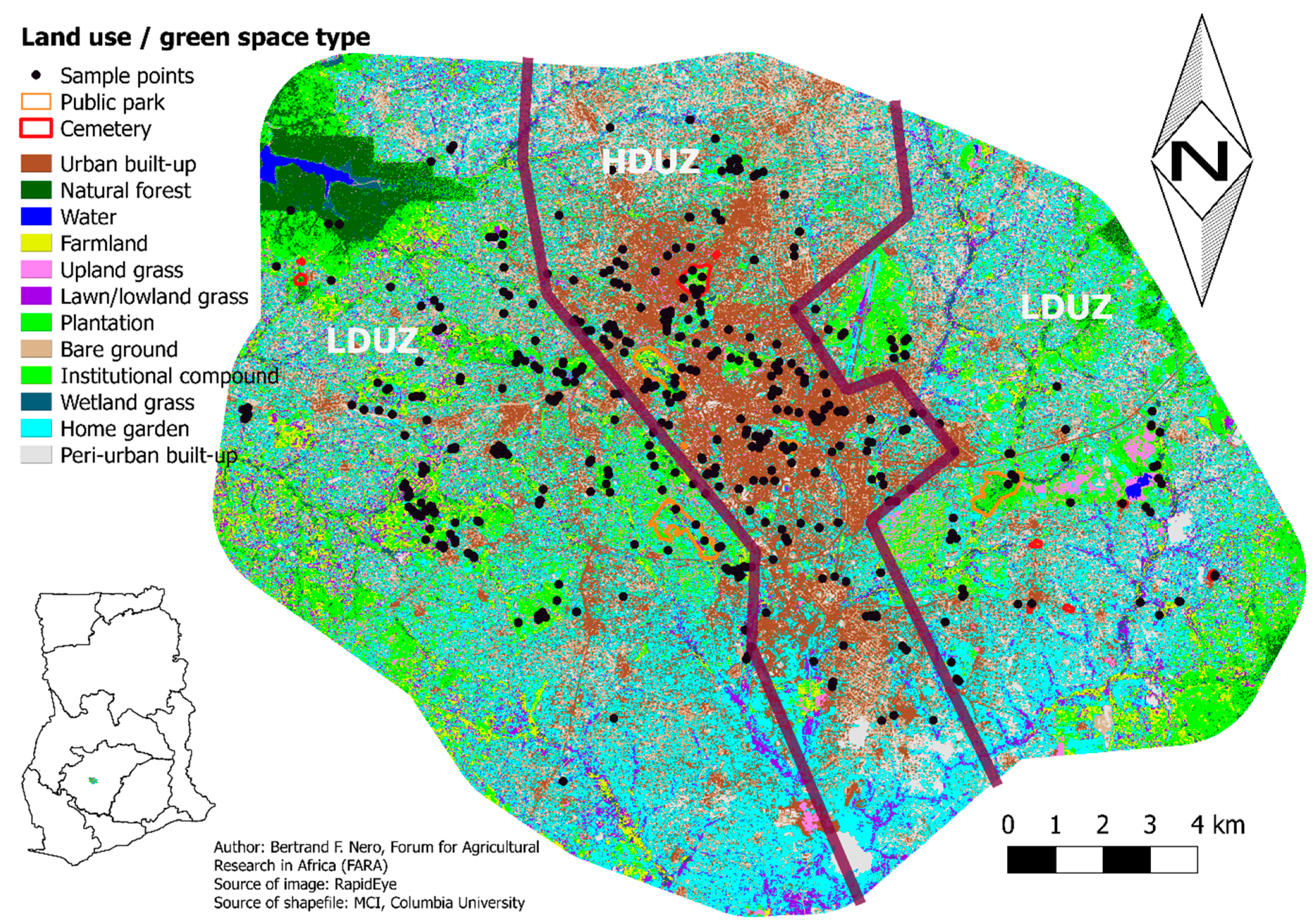
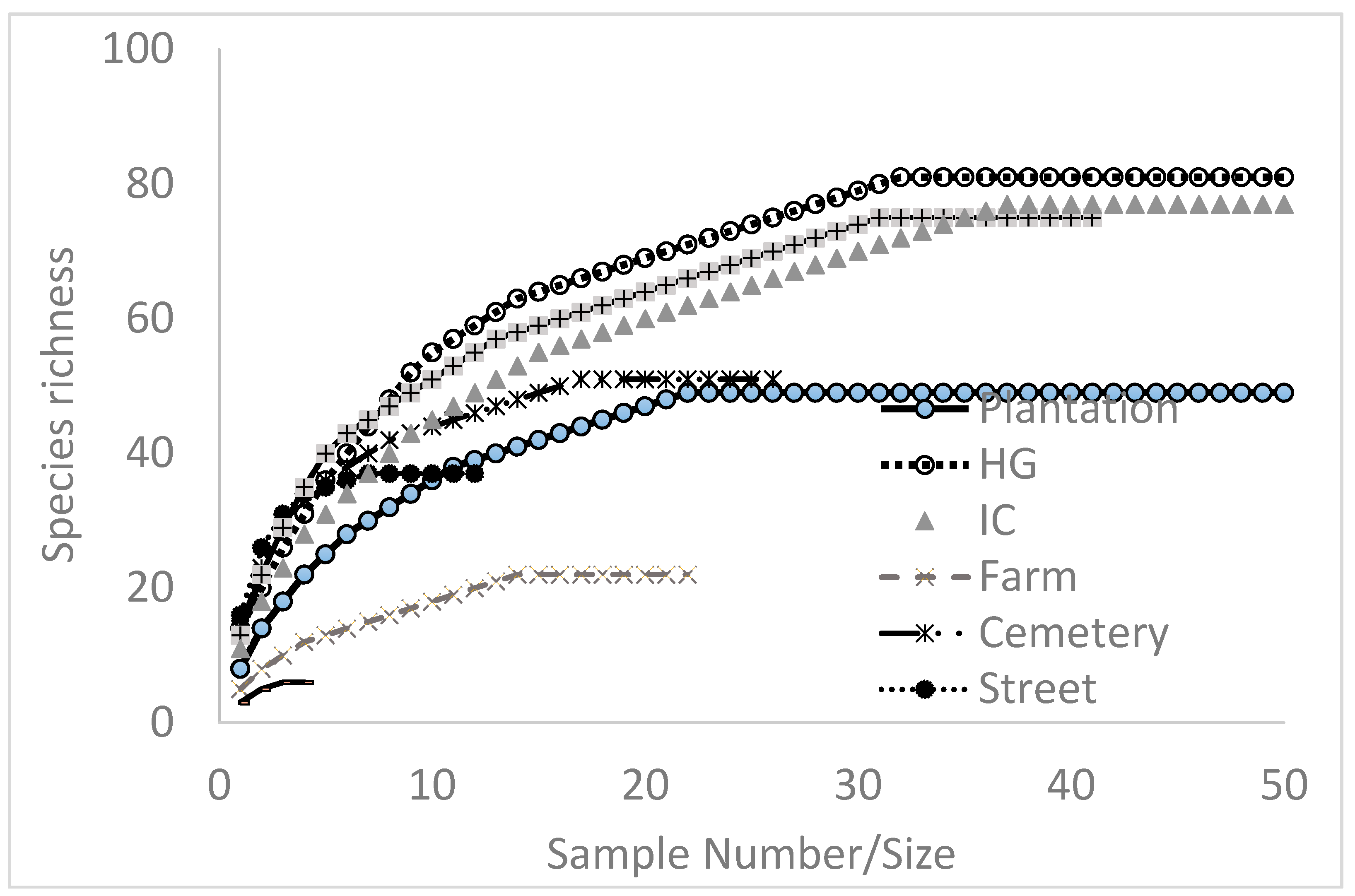
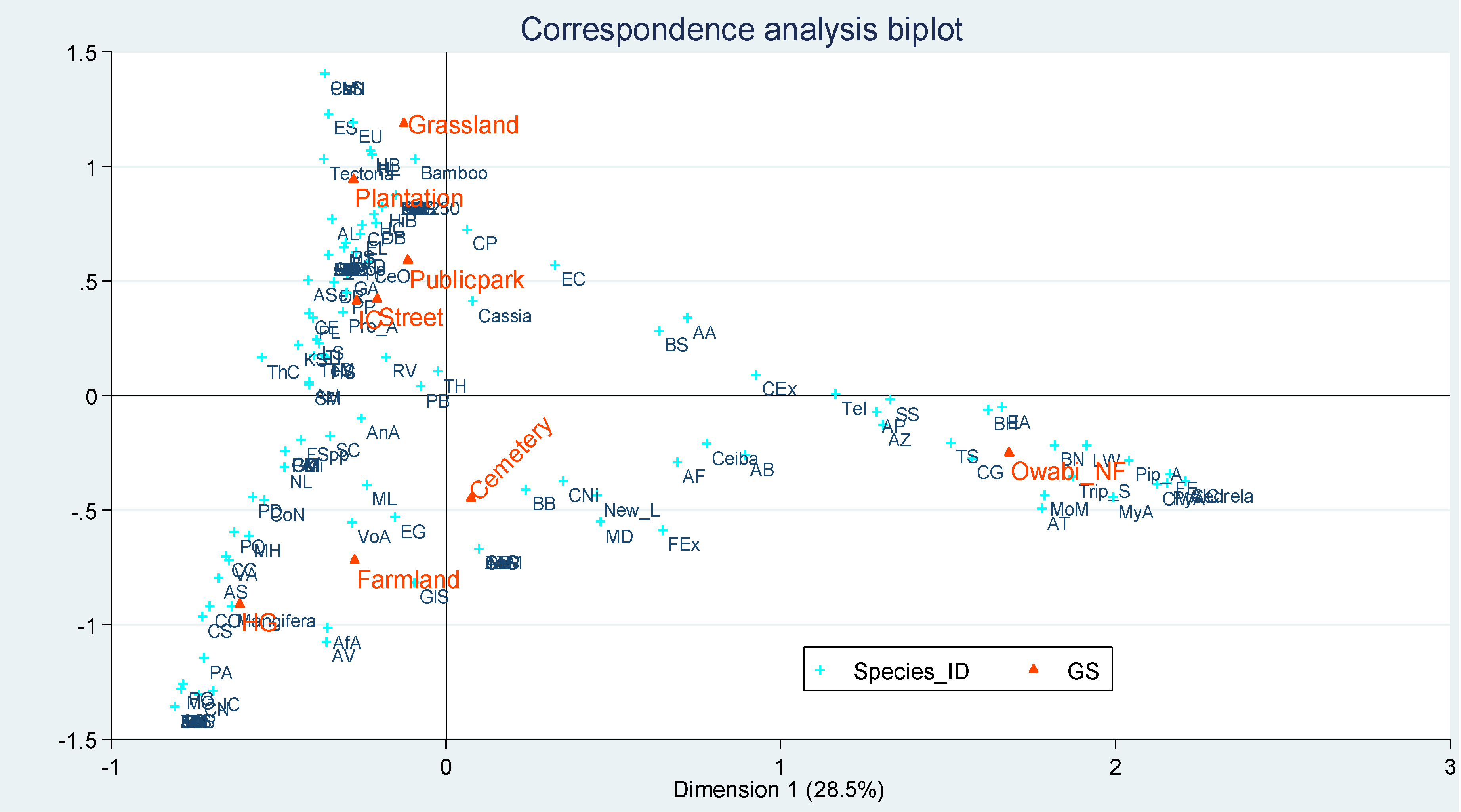
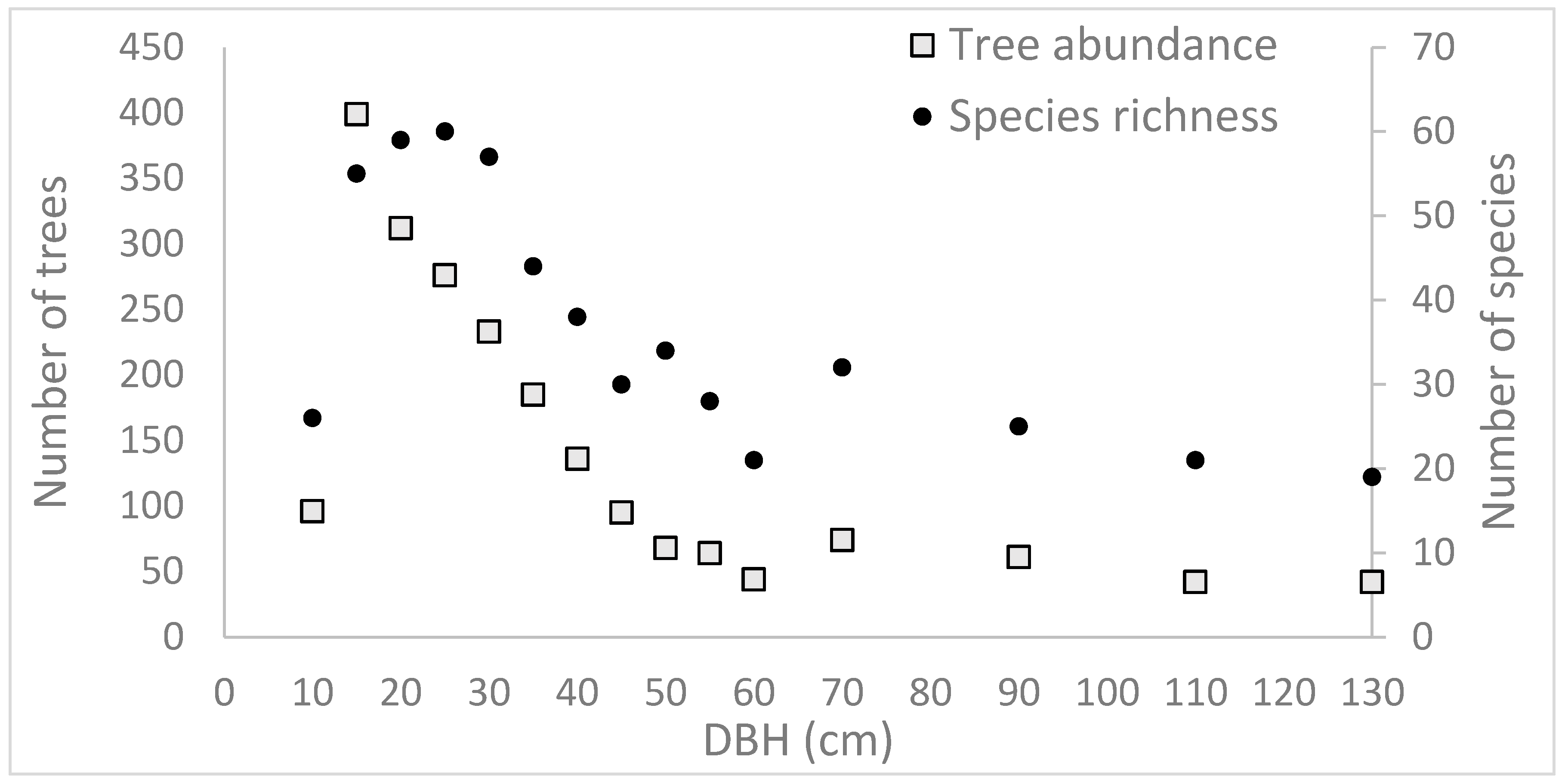
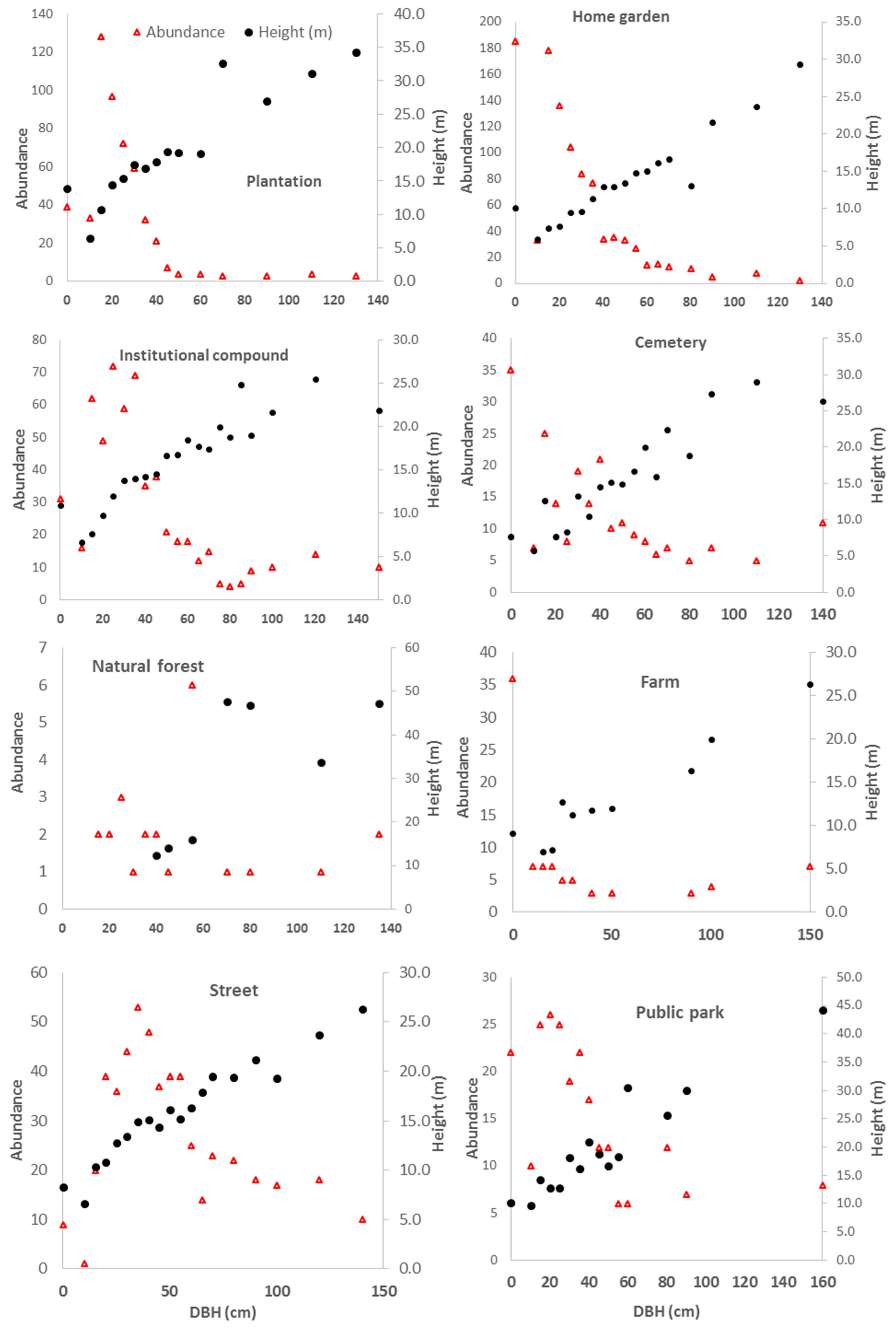

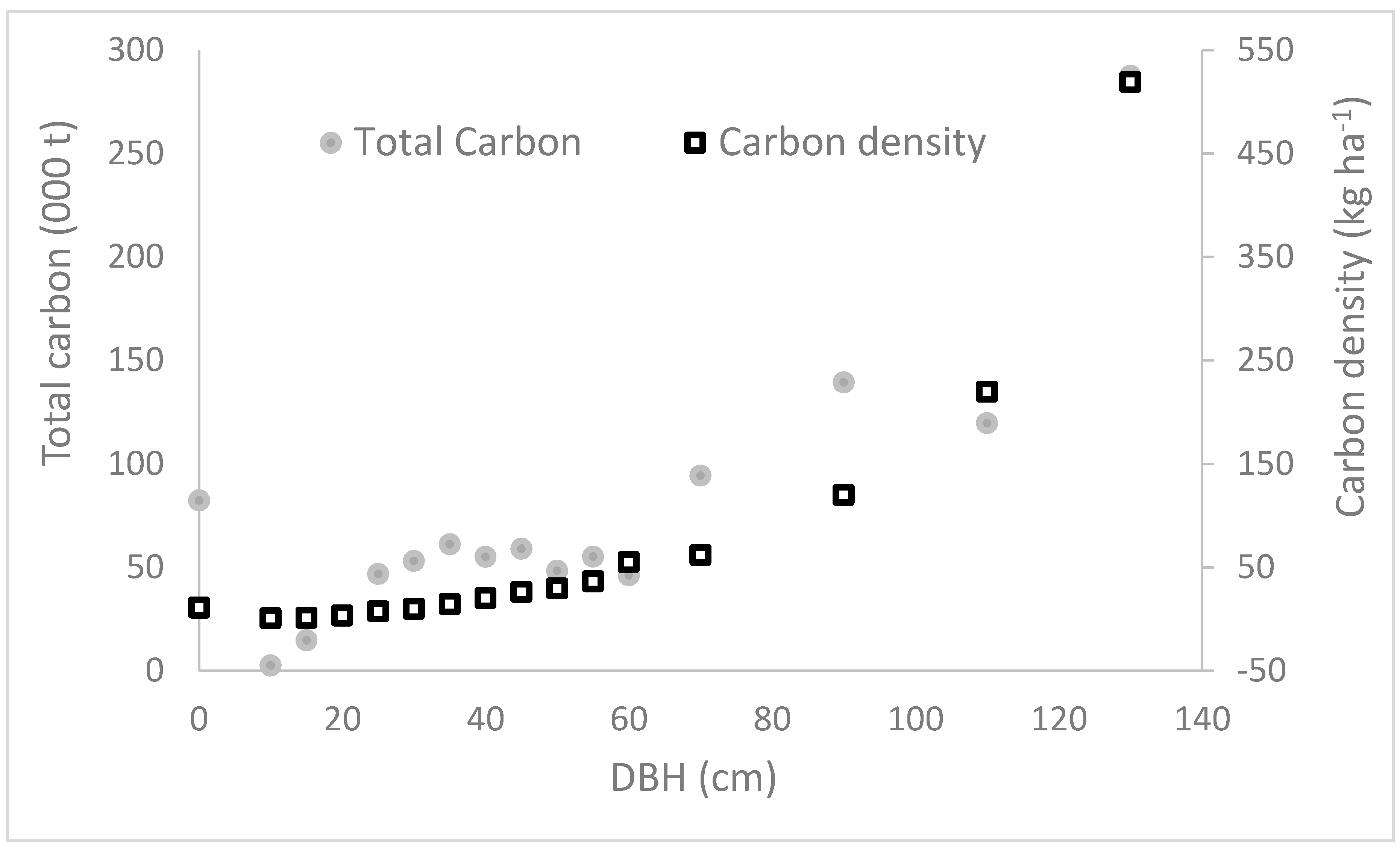
| Greenspace Type | Number of Individuals | Observed Richness, S | Estimated Chao1, Sest | Shannon H | Simpson 1-D | Pielou J (Evenness) |
|---|---|---|---|---|---|---|
| Plantation | 630 | 48 | 73.6 | 2.561 | 0.854 | 0.66 |
| Natural forest | 980 | 96 | 105 | 3.840 | 0.969 | 0.84 |
| Home garden | 1095 | 80 | 98.6 | 3.158 | 0.919 | 0.72 |
| Institutional Compound | 715 | 79 | 101.3 | 3.502 | 0.951 | 0.80 |
| Farm | 100 | 23 | 47.0 | 2.269 | 0.821 | 0.72 |
| Cemetery | 266 | 51 | 81.3 | 3.242 | 0.935 | 0.82 |
| Street | 565 | 37 | 57.2 | 2.809 | 0.903 | 0.78 |
| Public park | 334 | 75 | 127.7 | 3.521 | 0.952 | 0.82 |
| Grassland | 39 | 6 | 8.3 | 0.749 | 0.328 | 0.42 |
| Total | 3757 | 176 | 222.4 | 3.716 | 0.956 | 0.72 |
| UGS | Species |
|---|---|
| Home garden | Oil palm—Elaeis guineensis Jacq., Mango—Mangifera indica L., Pear—Persea americana Mill., Orange—Citrus sinensis (L) Osbeck, Coconut—Cocos nucifera L. |
| Street | Cassia—Cassia siamea Lam., Copper pod tree—Peltophorum pterocarpum (DC.) Backer ex K. Heyne, Cedrela—Cedrela odorata L., Indian almond—Terminalia catappa L., Flamboyant- Delonix regia (Bojer ex Hook). |
| Plantation | Teak—Tectona grandis L. f., Cocoa—Theobroma cacao L., Cassia siamea, Elaeis guineensis, White teak—Gmelina arborea (Roxb) |
| Institutional compound | Cassia siamea, Millettia thonningii (Schumach.) Baker, Weeping willow—Polyalthia longifolia (Sonn.) Thwaites, Elaeis guineensis, Casuarina equisetifolia L. |
| Cemetery | Elaeis guineensis, Brimstone tree—Morinda lucida (Benth.), Cassia siamea, Mangifera indica, Quickstick-Gliricidia sepium (Jacq.) Kunth ex Walp. |
| Public park | Cassia siamea, Elaeis guineensis, Millettia thonningii, Pelthophorum pterocarpum, Delonix regia |
| Farmland | Elaeis guineensis, Morinda lucida, Mangifera indica, African tulip—Spathodea campanulata P. Beauv, Kapok tree—Ceiba pentandra (L.) Gaertn. |
| Grassland | Ceiba pentandra, Pithecellobium dulce (Roxb.) Benth., Cedrela odorata, Mangifera indica, Morinda lucida |
| Natural forest | Cedrela odorata, Elaeis guineensis, Wawa—Triplochiton scleroxylon K. Schum., Funtumia elastic (Preuss) Stapf, Trichilia monodelpha (Thonn.) J. de Wilde |
| UGS | Tree Density No. ha−1 | DBH cm | Height m | BA m2 ha−1 | H:DBH m/cm |
|---|---|---|---|---|---|
| Streets | 44.1ab | 15.2bc | 0.34 | ||
| Cemeteries | 261cd | 44.0ab | 13.2cde | 83.8a | 0.30 |
| Farmlands | 175d | 45.5ab | 11.4de | 38.6c | 0.25 |
| Grasslands | 200d | 33.0cd | 12.9cde | 23.4c | 0.39 |
| Home gardens | 240d | 27.1cd | 10.0e | 24.0c | 0.37 |
| Institutional compounds | 321c | 35.3bc | 13.6cd | 71.3ab | 0.39 |
| Natural forest | 246d | 47.5a | 44.5a | 83.5a | 0.94 |
| Plantations | 825a | 23.2d | 14.4bcd | 65.0b | 0.62 |
| Public parks | 484b | 35.6bc | 17.1b | 84.9a | 0.48 |
| Mean | 377 | 33.3 | 13.0 | 55.6 | 0.39 |
| Least Square Difference | 10.6 | 3.5 |
| Urban Zone | Shared Species | Jaccard Index | Sørenson λ Index | ||||
|---|---|---|---|---|---|---|---|
| 95% LL | 95% UL | 95% LL | 95% UL | ||||
| HDUZ–LDUZ | 74 | 0.897 | 0.559 | 2.230 | 0.946 | 0.717 | 1.380 |
| LDUZ–NF 1 | 45 | 0.520 | 0.218 | 1.204 | 0.684 | 0.358 | 1.092 |
| HDUZ–NF | 27 | 0.312 | 0.135 | 0.605 | 0.476 | 0.239 | 0.754 |
© 2018 by the authors. Licensee MDPI, Basel, Switzerland. This article is an open access article distributed under the terms and conditions of the Creative Commons Attribution (CC BY) license (http://creativecommons.org/licenses/by/4.0/).
Share and Cite
Nero, B.F.; Callo-Concha, D.; Denich, M. Structure, Diversity, and Carbon Stocks of the Tree Community of Kumasi, Ghana. Forests 2018, 9, 519. https://doi.org/10.3390/f9090519
Nero BF, Callo-Concha D, Denich M. Structure, Diversity, and Carbon Stocks of the Tree Community of Kumasi, Ghana. Forests. 2018; 9(9):519. https://doi.org/10.3390/f9090519
Chicago/Turabian StyleNero, Bertrand Festus, Daniel Callo-Concha, and Manfred Denich. 2018. "Structure, Diversity, and Carbon Stocks of the Tree Community of Kumasi, Ghana" Forests 9, no. 9: 519. https://doi.org/10.3390/f9090519
APA StyleNero, B. F., Callo-Concha, D., & Denich, M. (2018). Structure, Diversity, and Carbon Stocks of the Tree Community of Kumasi, Ghana. Forests, 9(9), 519. https://doi.org/10.3390/f9090519





